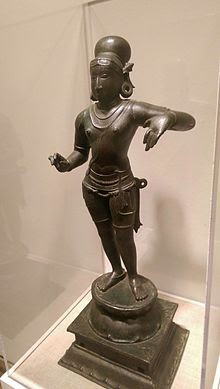Religious Movement
The Sufi Movement
- Mystics who are called Sufis rose in Islam at a very early stage
- These saints had nothing to do with the state
- They laid great emphasis on love as bond between God and the individual soul
- Sufi came out of the word Sooph meaning Wool
- They advocated life of purity and renunciation
- Sufism sprang from the doctrine of Wahadat-ul-Wujud or unity of being
- This doctrine was propounded by Ibn-ul-Arabi
- One and the earliest Sufis was Rabia a woman
- Sufis organized 12 orders or silsilas
Sufi Terminology
Sufi words Meaning
Shaikh - Spiritual teacher
Tasawwuf - Sufism
Murid - Disciple
Khanqah - The hospice
Sama - Musical recital
Raksa - Dance
Fana - Self annihilation
Khalifah - Successor
The bhakti Movement
The Bhakti Movement which stressed mystical union of the individual with God was initiated in South India by popular saint poets called Alvars, who represented the emotional side of Vaishnavism through collective songs called Prabandhas
It declined in the AD 10th century but was again revived as a philosophical and ideological movement by Acharyas like
Ramanuja whose disciple Ramananda took it to North India
South India : Shiva and Vishnu
North India : Rama and Krishna
- The real development of Bhakti took place in South India between the 7th and the 12th centuries
- The Bhakti saints came usually from the lower caste
- They disregarded case encouraged women to join and taught in the local vernacular language
- They considered that God has either a form or was formless
Ramanuja 1017 – 1137 AD
In the 11th century Ramanuja tried to assimilate Bhakti to the tradition of the Vedas
Moksha can be obtained through Karma, Gyan and Bhakti
He gave the concept of Vishishtadvaita
He encouraged Prabattimarga or path of self-surrender to God.
He invited the downtrodden to Vaishnavism.
Jnandeva 1275-96 AD
Progenitor of Bhakti Movement in Maharashtra
Namdeva 1270-1350 AD
He was a Nirguna Upasaka some of his abhangas are included in the Guru Granth Sahib
Ekanath 1533-99 AD
Born in Patan in Aurangabad published the first receivable edition of janesvari
He condemned caste system and accepted disciple from the lower caste
Tukaram 1598-1650 AD
He was a contemporary of Shivaji the greatest Marathi Bhakti poet and his views are similar to that of Kabir.
Great devotee of Vithal a form of God Vishnu
Ramadas 1608 – 81 AD
He was the spiritual guru of Shivaji
Established ashrams all over India
He wrote Dasabodha a didactic work which gave advice on all aspects of life
Guru Nanak 1469 – 1538 AD
- He was the founder of the Sikh Religion.
- Guru Nanak was born in Talwandi near Lahore.
- He condemned caste differences and rituals like bathing in holy rivers.
- He established a centre at Kartarpur named Dera Baba Nanak on the river Ravi. His idea of religion was highly practical and strictly moral.
- His one of the famous sayings was “Abide pure amidst the impurities of the world”.
- Nanak began the practice of community kitchen or Guru-ka-Langar
- He named the formless god as Akal Purush
- His teachings are compiled in the Adi Granth
Ramananda
Founder of Bhakti Movement In North India
He was born at Allahabad
He was inspired by Ramanujacharya.
Later he founded his own sect and preached his principles in Hindi at Banaras and Agra.
Ramananda was the first to employ the vernacular medium to spread his ideas.
He opposed the caste system and chose his disciples from all sections of society irrespective of caste.
Ramananda’s disciples were:
- Anantananda
- Sursurananda
- Sukhanand
- Naraharidāsa
- Bhavanand
- Bhagat Pipa
- Kabir
- Sen
- Dhanna
- Ravidas
Kabir
Kabir was the most famous disciple of Ramananda.
He was brought up by a Muslim couple who were weavers by profession.
He had a curious mind in learning new things and he learned much about Hinduism in Benares.
Kabir’s aim was to reunite Hindus and Muslims and form harmony between them.
He is regarded as the greatest of the mystic saints.
His followers are called Kabirpanthis.
In the 14th and 15th centuries, Ramananda, Kabir and Nanak remained the great apostles of the Bhakti cult.
They aided the common people to shed age-old superstitions and attain salvation through Bhakti or pure devotion.
Criticized all forms of worship of idols.
Chaitanya
Born in Nadia district of West Bengal
The founder of modern Vaishnav Sect of Bengal
Chaitanya was another renowned saint and reformer of Bengal who popularized the Krishna cult.
He believed that a devotee can feel the presence of God through song and dance and love and devotion.
Philosophy of Chaitanya was called Achityabhedaveda
Tulsidas 1532 – 1623 AD
He born in Brahmin family in Varanasi
He was a worshipper of Rama.
He composed the famous Ramcharitmanas, the Hindi version of Ramayana.
Guru Gobind Singh
He was the 10th Guru.
In 1706, he authenticated the compilation which was added with the writings of other figures like Shaikh Farid, Sant Kabir, Bhagat Namdev and Guru Tegh Bahadur, which is now known as Guru Granth Sahib.
Vallabhacharya 1479 – 1531 AD
He emphasized on the worhip of Krishna as an incarnation of the almighty God
He taught that there was no difference in Atma and Paramatma
He founded the Pushti Sect
Surdas 1486 – 4563 AD
Disciple of Vallabhacharya and devotee of lord Krshma and Radha
He wrote Sur Suravali Sahitya Ratna and Sursagar
Mirabai 1498-1546 AD
Married to Bhojraj
She was the Rathore princess of Mevata and daughter in law of Rana Sanga of Mewar
She belonged to the Krisha cult of Vaishnavism
Purandar Das 1480- 1564 AD
Foundation of Carnatic music
Vaishnava Saint
Thyagaraja 1767 – 1847
Telugu saint
Greatest composer of Carnatic music

.png)

